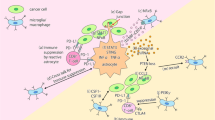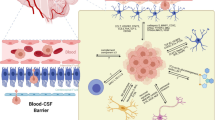Abstract
Interactions between tumor cells and the microenvironment are crucial to tumor formation and metastasis. The central nervous system serves as a “sanctuary” site for metastasis, resulting in poor prognosis in diagnosed patients. The incidence of brain metastasis is increasing; however, little is known about interactions between the brain and metastatic cells. Brain pathology was examined in an experimental model system of brain metastasis, using a subline of MDA-MB-231 human breast cancer cells. The results were compared with an analysis of sixteen resected human brain metastases of breast cancer. Experimental metastases formed preferentially in specific brain regions, with a distribution similar to clinical cases. In both the 231-BR model, and in human specimens, Ki67 expression indicated that metastases were highly proliferative (~50%). Little apoptosis was observed in either set of tumors. In the model system, metastases elicited a brain inflammatory response, with extensive reactive gliosis surrounding metastases. Similarly, large numbers of glial cells were found within the inner tumor mass of human brain metastases. In vitro co-cultures demonstrated that glia induced a ~5-fold increase in metastatic cell proliferation (P < 0.001), suggesting that brain tissue secretes factors conducive to tumor cell growth. Molecules used to signal between tumor cells and the surrounding glia could provide a new avenue of therapeutic targets for brain metastases.






Similar content being viewed by others
Abbreviations
- DAPI 4′6:
-
Diamidino-2-phenylindole
- EGFP:
-
Enhanced Green Fluorescent Protein
- GFAP:
-
Glial Fibrillary Acidic Protein
- H&E:
-
Hematoxylin and eosin
References
Weil RJ, Palmieri DC, Bronder JL et al (2005) Breast cancer metastasis to the central nervous system. Am J Pathol 167(4):913–920
Palmieri D, Smith QR, Lockman PR et al (2006) Brain metastases of breast cancer. Breast Dis 26:139–147
Palmieri D, Bronder JL, Herring JM et al (2007) Her-2 overexpression increases the metastatic outgrowth of breast cancer cells in the brain. Cancer Res 67(9):4190–4198. doi:10.1158/0008-5472.CAN-06-3316
Santarelli JG, Sarkissian V, Hou LC et al (2007) Molecular events of brain metastasis. Neurosurg Focus 22(3):E1. doi:10.3171/foc.2007.22.3.2
Cavaliere R, Schiff D (2007) Chemotherapy and cerebral metastases: Misperception or reality? Neurosurg Focus 22(3):E6. doi:10.3171/foc.2007.22.3.7
Chang EL, Lo S (2003) Diagnosis and management of central nervous system metastases from breast cancer. Oncologist 8(5):398–410. doi:10.1634/theoncologist.8-5-398
Neuwelt EA (2004) Mechanisms of disease: the blood-brain barrier. Neurosurgery 54(1):131–140. doi:10.1227/01.NEU.0000097715.11966.8E Discussion 41-2
van den Bent MJ, Hegi ME, Stupp R (2006) Recent developments in the use of chemotherapy in brain tumours. Eur J Cancer 42(5):582–588. doi:10.1016/j.ejca.2005.06.031
Drappatz J, Wen PY (2006) Chemotherapy and targeted molecular therapies for brain metastases. Expert Rev Neurother 6(10):1465–1479. doi:10.1586/14737175.6.10.1465
Chen EI, Hewel J, Krueger JS et al (2007) Adaptation of energy metabolism in breast cancer brain metastases. Cancer Res 67(4):1472–1486. doi:10.1158/0008-5472.CAN-06-3137
Fidler IJ, Schackert G, Zhang RD et al (1999) The biology of melanoma brain metastasis. Cancer Metastasis Rev 18(3):387–400. doi:10.1023/A:1006329410433
Kim LS, Huang S, Lu W et al (2004) Vascular endothelial growth factor expression promotes the growth of breast cancer brain metastases in nude mice. Clin Exp Metastasis 21(2):107–118. doi:10.1023/B:CLIN.0000024761.00373.55
Kusters B, Leenders WP, Wesseling P et al (2002) Vascular endothelial growth factor-a(165) induces progression of melanoma brain metastases without induction of sprouting angiogenesis. Cancer Res 62(2):341–345
Lu W, Bucana CD, Schroit AJ (2007) Pathogenesis and vascular integrity of breast cancer brain metastasis. Int J Cancer 120(5):1023–1026. doi:10.1002/ijc.22388
Saito N, Hatori T, Murata N et al (2007) A double three-step theory of brain metastasis in mice: The role of the pia mater and matrix metalloproteinases. Neuropathol Appl Neurobiol 33(3):288–298. doi:10.1111/j.1365-2990.2007.00799.x
Schackert G, Price JE, Zhang RD et al (1990) Regional growth of different human melanomas as metastases in the brain of nude mice. Am J Pathol 136(1):95–102
Yoneda T, Williams PJ, Hiraga T et al (2001) A bone-seeking clone exhibits different biological properties from the mda-mb-231 parental human breast cancer cells and a brain-seeking clone in vivo and in vitro. J Bone Miner Res 16(8):1486–1495. doi:10.1359/jbmr.2001.16.8.1486
Mendes O, Kim HT, Stoica G (2005) Expression of mmp2, mmp9 and mmp3 in breast cancer brain metastasis in a rat model. Clin Exp Metastasis 22(3):237–246. doi:10.1007/s10585-005-8115-6
Rye PD, Norum L, Olsen DR et al (1996) Brain metastasis model in athymic nude mice using a novel muc1-secreting human breast-cancer cell line, ma11. Int J Cancer 68(5):682–687. doi :10.1002/(SICI)1097-0215(19961127)68:5<682::AID-IJC20>3.0.CO;2-2
Gril B, Palmieri D, Bronder JL, Herring JM, Vega-Valle E, Feigenbaum L et al (in press) Effect of lapatinib on the outgrowth of metastatic breast cancer cells to the brain. Journal of the National Cancer Institute
Paget S (1889) Distribution of secondary growths in cancer of the breast. Lancet 1:571–573. doi:10.1016/S0140-6736(00)49915-0
Bhowmick NA, Moses HL (2005) Tumor-stroma interactions. Curr Opin Genet Dev 15(1):97–101. doi:10.1016/j.gde.2004.12.003
De Wever O, Mareel M (2003) Role of tissue stroma in cancer cell invasion. J Pathol 200(4):429–447. doi:10.1002/path.1398
Hoelzinger DB, Demuth T, Berens ME (2007) Autocrine factors that sustain glioma invasion and paracrine biology in the brain microenvironment. J Natl Cancer Inst 99(21):1583–1593. doi:10.1093/jnci/djm187
Li H, Fan X, Houghton J (2007) Tumor microenvironment: the role of the tumor stroma in cancer. J Cell Biochem 101(4):805–815. doi:10.1002/jcb.21159
Schedin P, O’Brien J, Rudolph M et al (2007) Microenvironment of the involuting mammary gland mediates mammary cancer progression. J Mammary Gland Biol Neoplasia 12(1):71–82. doi:10.1007/s10911-007-9039-3
Anderson KC (2007) Targeted therapy of multiple myeloma based upon tumor-microenvironmental interactions. Exp Hematol 35(4 Suppl 1):155–162. doi:10.1016/j.exphem.2007.01.024
Hideshima T, Mitsiades C, Tonon G et al (2007) Understanding multiple myeloma pathogenesis in the bone marrow to identify new therapeutic targets. Nat Rev Cancer 7(8):585–598. doi:10.1038/nrc2189
Novak U, Kaye AH (2000) Extracellular matrix and the brain: components and function. J Clin Neurosci 7(4):280–290. doi:10.1054/jocn.1999.0212
Rauch U (2004) Extracellular matrix components associated with remodeling processes in brain. Cell Mol Life Sci 61(16):2031–2045. doi:10.1007/s00018-004-4043-x
de Vries NA, Beijnen JH, Boogerd W et al (2006) Blood-brain barrier and chemotherapeutic treatment of brain tumors. Expert Rev Neurother 6(8):1199–1209. doi:10.1586/14737175.6.8.1199
Engelhardt B (2006) Molecular mechanisms involved in t cell migration across the blood-brain barrier. J Neural Transm 113(4):477–485. doi:10.1007/s00702-005-0409-y
Streit WJ, Conde JR, Fendrick SE et al (2005) Role of microglia in the central nervous system’s immune response. Neurol Res 27(7):685–691
Sofroniew MV (2005) Reactive astrocytes in neural repair and protection. Neuroscientist 11(5):400–407. doi:10.1177/1073858405278321
Kobori N, Clifton GL, Dash P (2002) Altered expression of novel genes in the cerebral cortex following experimental brain injury. Brain Res Mol Brain Res 104(2):148–158. doi:10.1016/S0169-328X(02)00331-5
Long Y, Zou L, Liu H et al (2003) Altered expression of randomly selected genes in mouse hippocampus after traumatic brain injury. J Neurosci Res 71(5):710–720. doi:10.1002/jnr.10524
Matzilevich DA, Rall JM, Moore AN et al (2002) High-density microarray analysis of hippocampal gene expression following experimental brain injury. J Neurosci Res 67(5):646–663. doi:10.1002/jnr.10157
Natale JE, Ahmed F, Cernak I et al (2003) Gene expression profile changes are commonly modulated across models and species after traumatic brain injury. J Neurotrauma 20(10):907–927. doi:10.1089/089771503770195777
Raghavendra Rao VL, Dhodda VK, Song G et al (2003) Traumatic brain injury-induced acute gene expression changes in rat cerebral cortex identified by genechip analysis. J Neurosci Res 71(2):208–219. doi:10.1002/jnr.10486
Sun L, Lee J, Fine HA (2004) Neuronally expressed stem cell factor induces neural stem cell migration to areas of brain injury. J Clin Invest 113(9):1364–1374
Bezzi P, Volterra A (2001) A neuron-glia signalling network in the active brain. Curr Opin Neurobiol 11(3):387–394. doi:10.1016/S0959-4388(00)00223-3
Giaume C, Kirchhoff F, Matute C et al (2007) Glia: the fulcrum of brain diseases. Cell Death Differ 14(7):1324–1335. doi:10.1038/sj.cdd.4402144
Heyn C, Ronald JA, Ramadan SS et al (2006) In vivo mri of cancer cell fate at the single-cell level in a mouse model of breast cancer metastasis to the brain. Magn Reson Med 56(5):1001–1010. doi:10.1002/mrm.21029
Zhang RD, Fidler IJ, Price JE (1991) Relative malignant potential of human breast carcinoma cell lines established from pleural effusions and a brain metastasis. Invasion Metastasis 11(4):204–215
Delattre JY, Krol G, Thaler HT et al (1988) Distribution of brain metastases. Arch Neurol 45(7):741–744
Hwang TL, Close TP, Grego JM et al (1996) Predilection of brain metastasis in gray and white matter junction and vascular border zones. Cancer 77(8):1551–1555. doi :10.1002/(SICI)1097-0142(19960415)77:8<1551::AID-CNCR19>3.0.CO;2-Z
Busch SA, Silver J (2007) The role of extracellular matrix in cns regeneration. Curr Opin Neurobiol 17(1):120–127. doi:10.1016/j.conb.2006.09.004
Ajtai BM, Kalman M (2001) Reactive glia support and guide axon growth in the rat thalamus during the first postnatal week. A sharply timed transition from permissive to non-permissive stage. Int J Dev Neurosci 19(6):589–597. doi:10.1016/S0736-5748(01)00038-7
Colodner KJ, Montana RA, Anthony DC et al (2005) Proliferative potential of human astrocytes. J Neuropathol Exp Neurol 64(2):163–169
Graeber MB, Scheithauer BW, Kreutzberg GW (2002) Microglia in brain tumors. Glia 40(2):252–259. doi:10.1002/glia.10147
Nuttall RK, Silva C, Hader W et al (2007) Metalloproteinases are enriched in microglia compared with leukocytes and they regulate cytokine levels in activated microglia. Glia 55(5):516–526. doi:10.1002/glia.20478
Nishizuka I, Ishikawa T, Hamaguchi Y et al (2002) Analysis of gene expression involved in brain metastasis from breast cancer using cdna microarray. Breast Cancer (Tokyo, Japan) 9(1):26–32
Acknowledgements
We would like to thank Hong Wang (Developmental Neurobiology Section of the NHLBI Division of Intramural Research, NIH) for providing mixed glial cultures used in the soft agar experiments. This research was supported by the US Department of Defense Breast Cancer Research Program, grant number: W81 XWH-062-0033; and the Intramural Research Program of the National Cancer Institute, CCR, NIH.
Author information
Authors and Affiliations
Corresponding author
Rights and permissions
About this article
Cite this article
Fitzgerald, D.P., Palmieri, D., Hua, E. et al. Reactive glia are recruited by highly proliferative brain metastases of breast cancer and promote tumor cell colonization. Clin Exp Metastasis 25, 799–810 (2008). https://doi.org/10.1007/s10585-008-9193-z
Received:
Accepted:
Published:
Issue Date:
DOI: https://doi.org/10.1007/s10585-008-9193-z




